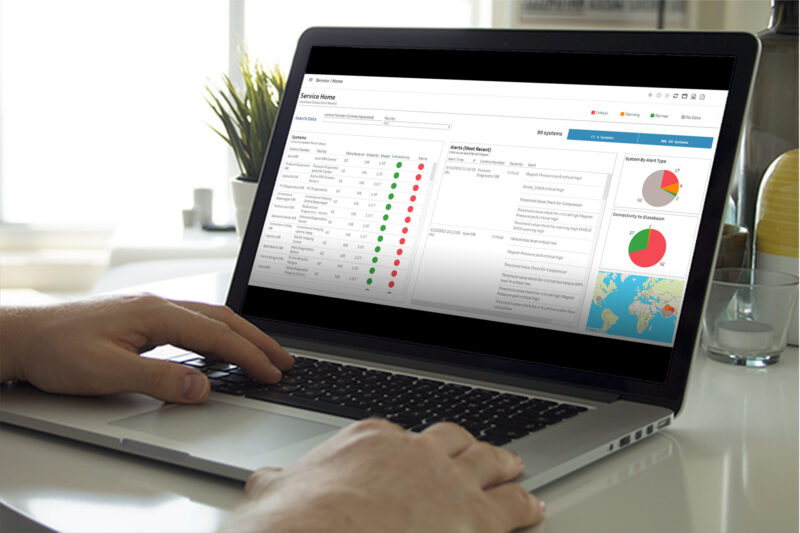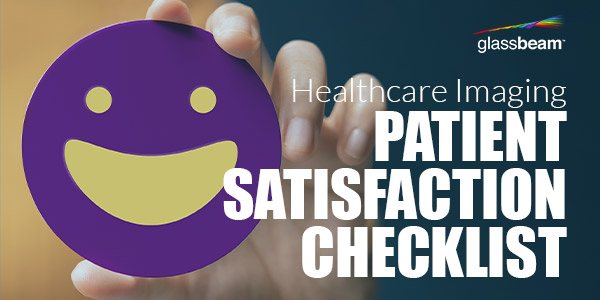
10 Tips for Improving Patient Satisfaction in an Imaging Organization
High patient satisfaction ratings can have a number of positive effects on a healthcare imaging provider. Providers that focus on providing high-quality care and improving patient satisfaction can improve their bottom line, create a more positive work environment for its staff, and increase patient volume and retention. According to a Harvard Business Review article, analyses of data collected by Press Ganey has shown that hospitals with better patient experience ratings have better business performance. The data revealed that there is a pronounced association between improvement in overall hospital rating and financial performance. For every five-point increase in hospital rating there is a one percent increase in profit margin.
Improving patient satisfaction is also essential for building strong patient-provider relationships. Satisfied patients lead to positive online reviews, HCAHPS (Hospital Consumer Assessment of Healthcare Providers and Systems) results, and Press Ganey scores, which can result in increased referrals and reimbursements. When patients are happy with their care, they are more likely to refer others to the same healthcare imaging provider.
Patient satisfaction is a key performance indicator many imaging providers track and measure. However, even with patient satisfaction data, it can still be challenging to know where to start when it comes to improving patient satisfaction. Following are several recommendations imaging leaders should consider if improving patient satisfaction is a priority for their organization.
Communicate Effectively with Patients
Imaging providers who prioritize communication with their patients build trust, rapport, and understanding, which can improve patient satisfaction significantly. From the time a patient books their first appointment until the results of the exam are received, there are continuous opportunities for communication. While exam delays, delayed results, and other issues will arise, it’s how the imaging staff communicates this information to the patients that makes the difference.
Long wait times for an imaging exam can be a big pain point for patients and can lead to negative patient feedback as well as poor scores on patient satisfaction surveys. Imaging organizations that communicate why there’s a delay can make the wait time feel much shorter for the patient. Most patients are understanding when an imaging organization’s staff is respectful and takes the time to explain what’s happening. This builds trust with the patient and improves patient satisfaction with the imaging provider.
Many patients fear the unknown and may be anxious about a CT scan if they’ve never had one. They may be unfamiliar with the procedure and aren’t sure what to expect. Rad techs who take the time to walk a patient through the procedure, provide clear and concise instructions, and answer any questions the patient may have can help reduce the patient’s anxiety and build trust, which results in greater patient satisfaction.
Map Out the Patient Journey
Imaging organizations that are focused on improving patient satisfaction need to make sure their strategy clearly defines what the patient experience and patient satisfaction should look like. According to a recent American Hospital Association Market Scan, patients regularly point to consumer-focused companies in other industries as examples of what they expect their healthcare provider to offer — personalized health care services, value-based pricing, and an elevated experience.
Mapping the patient journey throughout an imaging organization can be a useful tool to help leaders identify where disruptors are to the patient experience. The journey should involve as many staff as possible who provide care in the organization. Mapping the patient journey helps the imaging staff identify disruptors to a patient’s experience and evaluate opportunities to streamline the patient’s journey in their organization. For Example, if a rad tech doesn’t explain the steps of an MRI scan to a patient, the patient can panic from the unknown and become claustrophobic. The rad tech would have to stop the exam and pull the patient out of the gantry. If the organization had a standardized patient communication process for exams, the disruption to the exam may have been avoided. This is an opportunity for improvement, and would help increase patient satisfaction.
Define and Measure Imaging-Specific KPIs
Imaging leaders need to establish clear metrics and imaging-specific key performance indicators (KPIs) to measure progress against their organization’s performance goals. Once the KPIs are defined, the imaging organization needs to standardize on the KPIs and cascade them throughout the organization.
The specific metrics that are tracked will vary depending on the needs of the imaging provider. By tracking these metrics, imaging providers can identify areas where they can improve the patient experience and make changes to improve patient satisfaction scores. There are several metrics that can be used to track patient satisfaction, but some of the more common ones are:
- Overall satisfaction: The patient’s overall satisfaction with their care on a scale of 1 to 10
- Communication: The patient’s satisfaction with the communication they received from their healthcare team
- Wait times: The patient’s satisfaction with the wait times they experienced
- Cleanliness: The patient’s satisfaction with the cleanliness of the environment
- Friendliness: The patient’s satisfaction with the friendliness and helpfulness of the staff
- Privacy: The patient’s satisfaction with the privacy they felt during their care
- Overall experience: The patient’s overall experience with their care on a scale of 1 to 10
- Patient complaints: The number of complaints that are received from patients
- Patient referrals: The number of patients who refer their friends and family to the imaging provider
- Patient retention: The number of patients who return to the imaging provider for future imaging exams
By tracking these metrics, imaging providers can get a better understanding of how patients are experiencing their care and make changes to improve their patient satisfaction scores.
Leverage Utilization Analytics to Optimize Patient Experience
Utilization analytics can be an invaluable tool for improving patient satisfaction and providing insights into the operations of a healthcare imaging organization. Utilization analytics combine logs, DICOM, HL7, RIS, EMR, billing, and scheduling data, which allow imaging providers to optimize workflow, operator performance, and patient experience.
Machine learning and artificial intelligence can help improve the patient experience with quicker, more precise imaging and interpretation. Imaging providers rely on utilization analytics to identify areas where unnecessary tests are being ordered, which can result in reduced wait times, lower costs, and better patient outcomes.
Utilization analytics that encompass an imaging provider’s entire fleet allows it to optimize and coordinate patient-centric care and enable the automation required to consistently deliver quality on-demand care, a key to patient satisfaction.
Utilization analytics also benefit physicians by receiving real-time patient care insights and alerts via the EMR at the point of care to target and treat high-risk conditions. These type of analytics also allow patients to access personalized information more readily, including health records, lab tests, and billing.
Imaging providers can leverage utilization analytics to create dynamic staffing and patient scheduling models, manage patient flow inside facilities, and share real-time clinical data and information with the right people and facilities. These analytics can help providers increase care quality, care outcomes, and patient satisfaction.
Download the PATIENT SATISFACTION CHECKLIST to ensure your imaging department is implementing modern best practices.
Measure Exam Turnaround Time
Exam turnaround time is an important KPI that measures the time that it takes to complete an individual imaging exam — from the time the patient arrives to the time the results are available to the referring physician. This KPI is critical for patient care, as it can impact the speed of diagnosis and treatment. It is important to track exam turnaround time to ensure that patients are not waiting too long for their results. Reducing the turnaround time can improve patient satisfaction and increase patient volume.
Healthcare imaging organizations can use advanced utilization analytics to have better visibility into patient exam turnaround times for an individual medical imaging device or the number of exams performed during a specific time against benchmarks or other rad techs. Depending on an imaging organization’s goals, there are several metrics that can be measured to identify and understand where there are bottlenecks or breakdowns in turnaround times.
Arrival-to-exam time: This metric measures the time from the patient’s arrival at the imaging provider to the start of the exam. By monitoring this metric, imaging organizations can identify bottlenecks in the patient flow and make changes to reduce waiting times, such as increasing staff or optimizing scheduling.
Patient wait time: This metric measures the time taken for the patient to wait for their exam to start. By monitoring this metric, imaging organizations can identify any delays in patient flow and make changes to reduce waiting times, such as optimizing scheduling or increasing staff.
Exam duration: This metric measures the time taken to complete the radiology exam. By examining this metric, imaging organizations can identify any inefficiencies in the exam process and make changes to streamline procedures and reduce exam time.
Image availability: This metric measures the time taken to make the radiology images available for interpretation by the radiologist. Imaging organizations can use this metric to identify any delays in making images available for interpretation, and make changes to the imaging process to improve efficiency and reduce image availability time.
Report turnaround time: This metric measures the time taken to generate and deliver the radiology report to the referring physician. Imaging organizations can use this metric to identify any delays in generating and delivering reports, and make changes to the reporting process to improve efficiency and reduce report turnaround time.
Exam completion rate: This metric measures the percentage of exams completed within a certain timeframe. Imaging organizations can use this metric to identify any inefficiencies in the exam process and make changes to streamline procedures and improve exam completion rates.
Staff productivity: This metric measures the efficiency of the radiology staff in completing exams within a given timeframe. By monitoring this metric, imaging organizations can identify any inefficiencies in the staff’s work processes and make changes to improve productivity and reduce exam turnaround time.
Equipment downtime: This metric measures the time taken to repair or replace equipment that may affect the overall turnaround time. Imaging organizations can use this metric to identify any equipment issues that may affect exam turnaround time and make changes to reduce downtime, such as increasing maintenance or upgrading equipment.
Healthcare imaging organizations that invest in utilization analytics can use the insights to help them diagnose issues and identify solutions to reduce exam turnaround times, resulting in reduced costs, more efficiency, and a better patient experience.
Track Exam Volume Metrics
Exam volume is another important KPI that measures the number of imaging exams performed by a healthcare imaging provider in a given period of time. Exam volume can be tracked by type of imaging exam, patient population, modality, asset, or facility. Tracking exam volume allows imaging providers to gain valuable insights that can be used to improve patient care, increase efficiency, enhance quality, and reduce costs.
By tracking exam volume, imaging providers can identify areas where processes can be streamlined and quality can be improved. This can lead to improved efficiency, better patient outcomes, and an increase in staff satisfaction.
Imaging providers that track exam volume can identify if there are certain times of day or days of the week when the volume of exams is particularly high. Providers can then use this information to optimize staffing and hours of operation. This improves efficiency, staff satisfaction and allocation of capital investment funds.
Exam volume data can also help identify if certain types of exams have a higher rate of errors than others. This information can be evaluated by imaging leaders to determine if more operator training is needed to improve the quality of exams.
Invest in Predictive Analytics
Many imaging organizations still rely purely on historical data to solve challenges, which keeps them in a reactive position and leads to a continuous loop of stagnation. Leveraging artificial intelligence and machine learning results in prescriptive, actionable solutions. Predictive analytics can help healthcare imaging organizations and their service providers in several ways.

Healthcare imaging organizations that invest in predictive analytics arm their service provider with the ability to anticipate when a machine will be down outside of its regular maintenance schedule due to a component failure. Anomaly detection is used to identify early warning trends, providing actionable insights. For Example, based on historical data, predictive analytics can often predict a CT tube failure more than a week in advance. This allows the imaging organization to schedule overnight maintenance with a vendor or shift patients to another CT system/site to minimize patient impact and loss of revenue.
A service provider that needs to optimize service costs for a fleet of CT machines and other fixed assets for an imaging organization can apply predictive analytics to better plan parts procurement, rather than being reactive and purchasing them immediately following an unexpected failure. This enables the service provider to reduce costs and maximize operational efficiency for the imaging organization.
Predictive analytics can also help imaging organizations optimize their workflows and resource allocation, reducing wait times, decreasing the number of unnecessary tests, and improving overall efficiency. In addition, the analytics help imaging organizations manage their resources more effectively, ensuring that equipment and staff are available when and where they are needed.
Clinically, predictive analytics can improve patient outcomes and satisfaction by identifying patients who are at higher risk of developing certain conditions or diseases. This allows imaging organizations to provide earlier and more targeted interventions that can improve patient outcomes. Predictive analytics can also provide radiologists with valuable insights into patient conditions, allowing them to make more informed decisions about diagnosis and treatment and avoid unnecessary tests.
Optimize Patient Scheduling
Maximizing scheduling capacity improves patient access as well as patient satisfaction. With predictive data analytics, healthcare imaging providers can predict future patient scheduling needs, anticipate workflow interruptions, and share scheduling information to optimize facility and the radiology staff’s capacity.
Utilizing predictive data analytics, hospitals and medical practices can predict future scheduling needs and share scheduling information to optimize facility and clinician capacity. Real-time information enables them to book patient appointments strategically. Using predictive analytics, an imaging organization can schedule patients with the same types of exams close together and schedule exams that have a higher variability, such as a patient with claustrophobia, later in the day to minimize disruptions to the schedule. Maximizing scheduling capacity can increase staff satisfaction, improve patient access, and provide a positive ROI for fixed assets such as medical imaging devices.
Collect and Act on Patient Feedback
Having a way to capture the voice of the patient and their experience with a healthcare imaging provider is an important measure of patient satisfaction. Surveying patients and gathering feedback about their general experience at a facility and with staff can help identify patient experience disruptors. Survey tools like Press Ganey and HCHAPS are effective tools for providing patient satisfaction feedback. However, a drawback is the survey results aren’t available immediately. Imaging organizations can supplement those surveys by conducting their own surveys via automated emails, text, or postcards. This allows the imaging staff to get more immediate feedback about their processes, identify opportunities for improvement, and to connect directly with a patient if there’s an issue.
Frequently monitoring social media sites and review platforms like Yelp can help imaging organizations improve patient satisfaction too. Patients often share their experiences online and explain why they would or would not recommend an imaging provider. These online reviews can provide immediate feedback and usually give the provider an opportunity to quickly address potential issues. These reviews can supplement survey feedback, but they also play a critical role in a healthcare imaging provider’s reputation management and growth. Prospective patients who read about great patient experiences at a particular imaging provider are more likely to schedule their appointment with that provider. According to an article in Forbes, 81 percent of patients evaluate reviews before choosing a healthcare provider. This makes monitoring online reviews crucial for healthcare imaging providers that want to improve patient satisfaction.
Benefits of Improving Patient Satisfaction
There are many benefits for healthcare imaging organizations that focus on improving patient satisfaction. Often, the first interaction with a healthcare provider for many adults occurs when they visit an imaging provider for an exam. This experience can influence the patient’s future care decisions and which imaging provider they prefer to use.
Patients who are satisfied with their care are more likely to return to the same imaging provider for future imaging exams and refer their friends and family to the same provider. The result is imaging providers with high patient satisfaction scores retain their patients, gain patient loyalty, have better patient outcomes, and an increase in revenue.
Explore the Possibilities with Glassbeam Service and Utilization Analytics
With more than 1 million exams examined each day by Glassbeam solutions, see how top organizations are transforming their log data into impactful insights.
Transform Your Healthcare Operations
See how to gain deeper, clearer insight from your machine data to elevate business intelligence and to improve your operational uptime, utilization, and efficiency.

